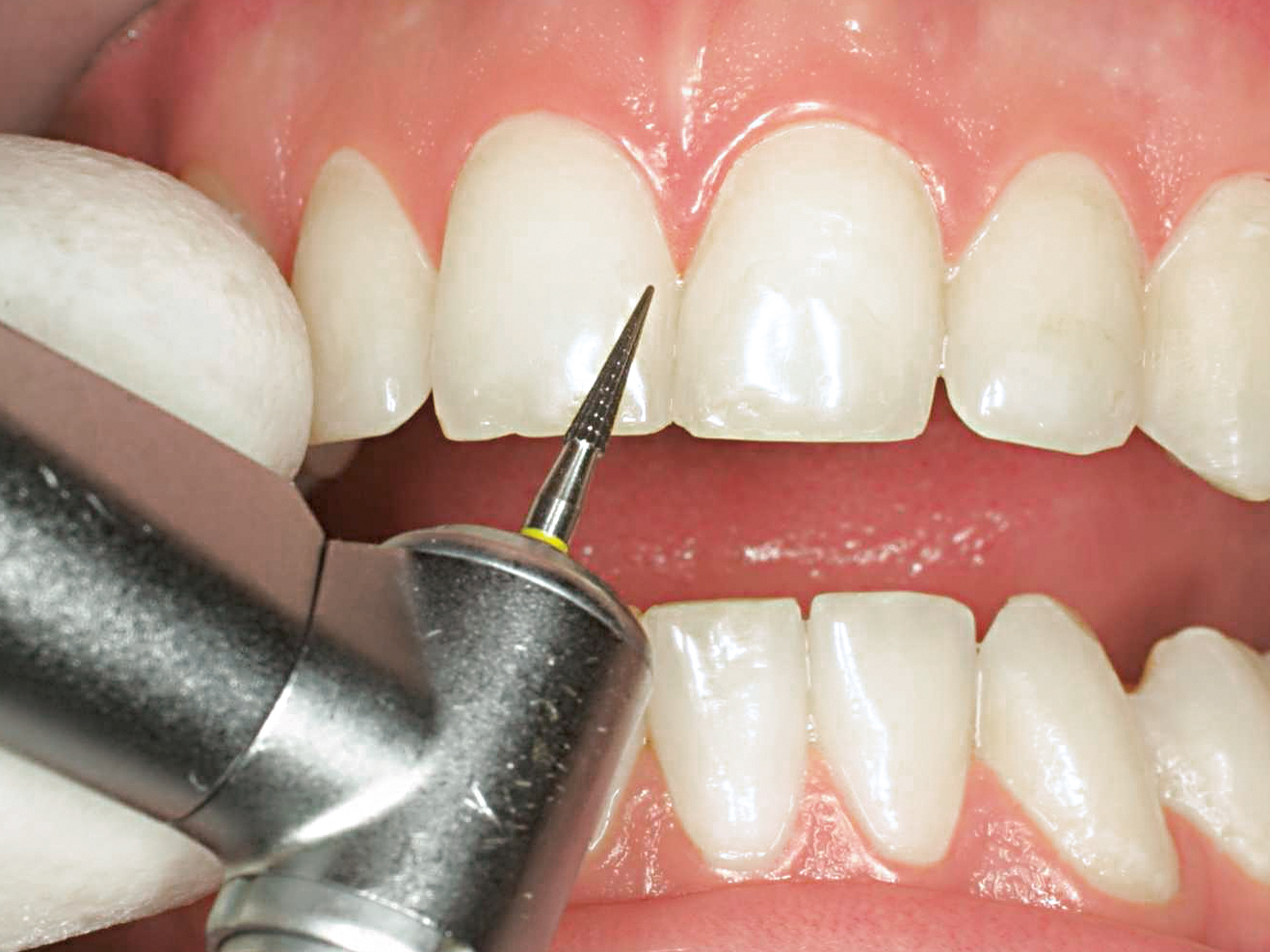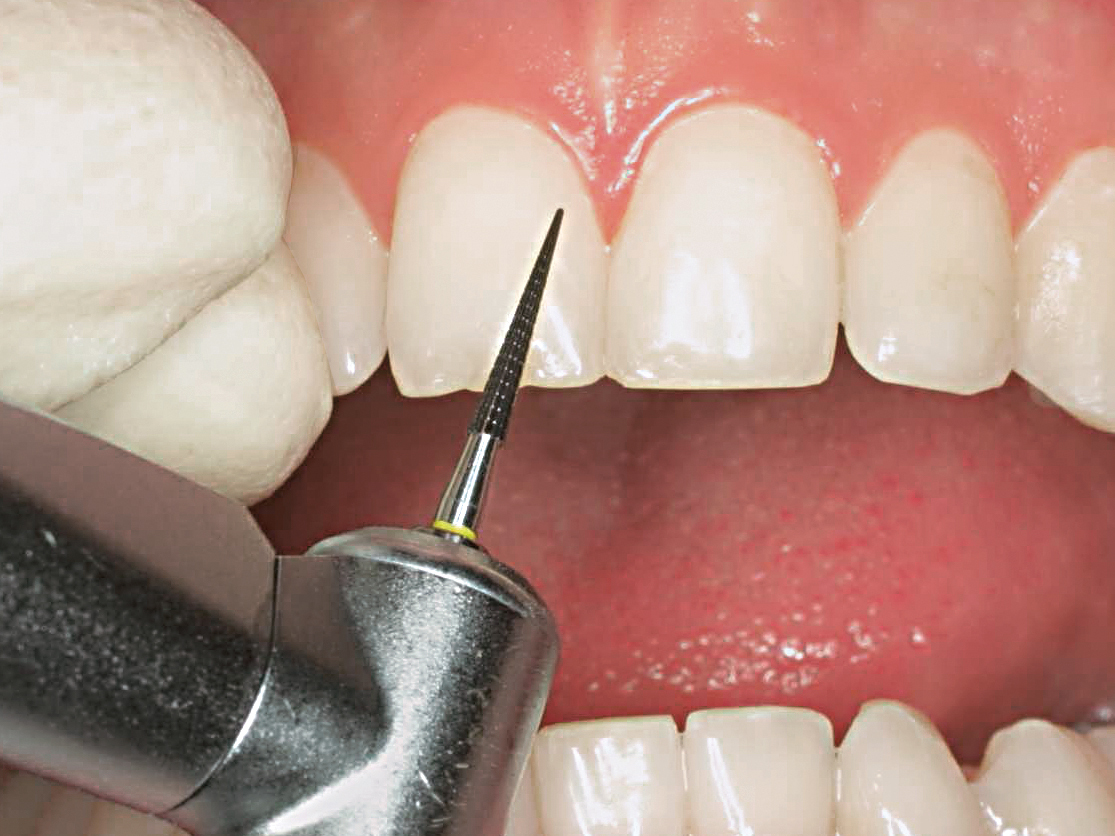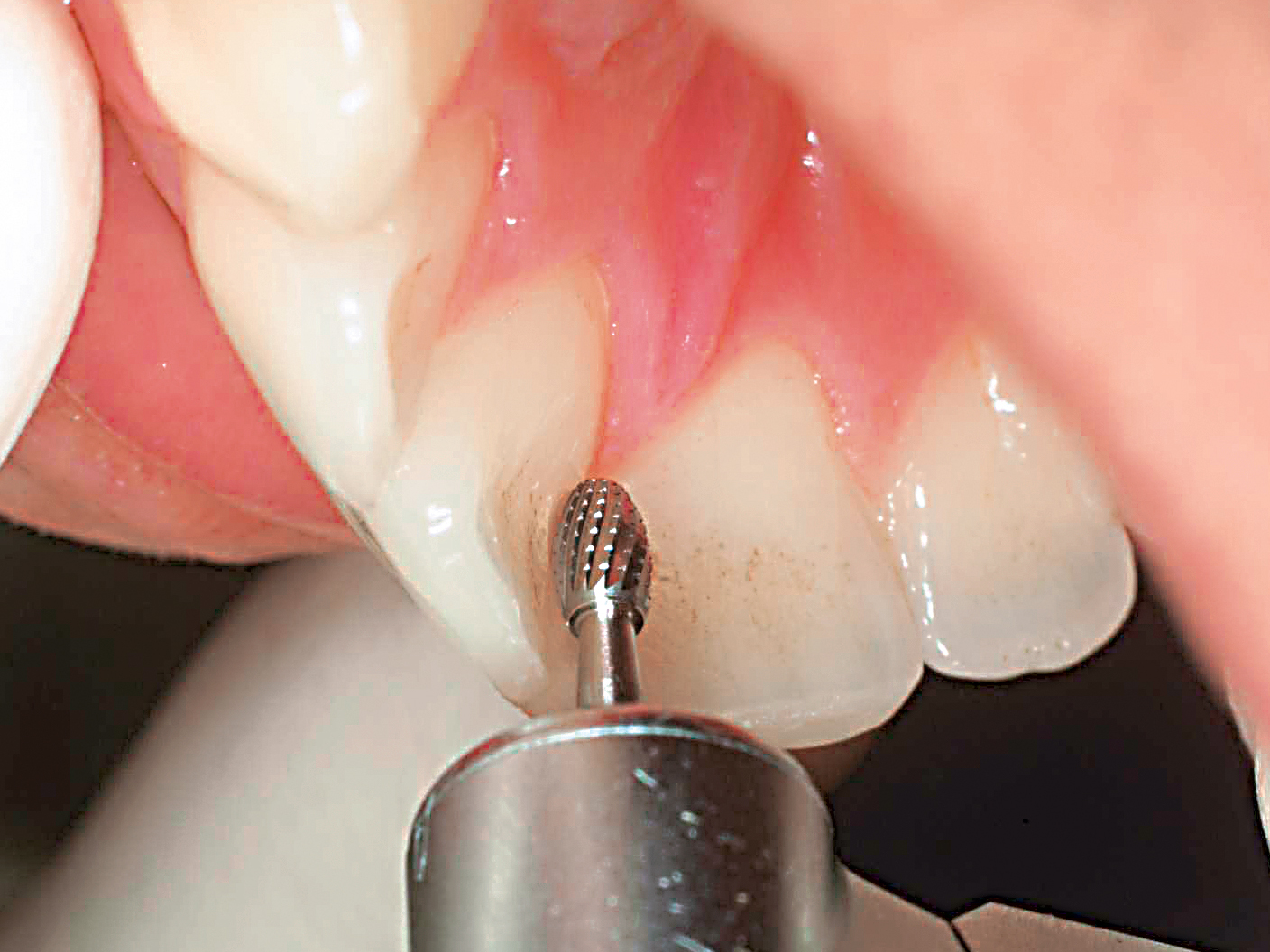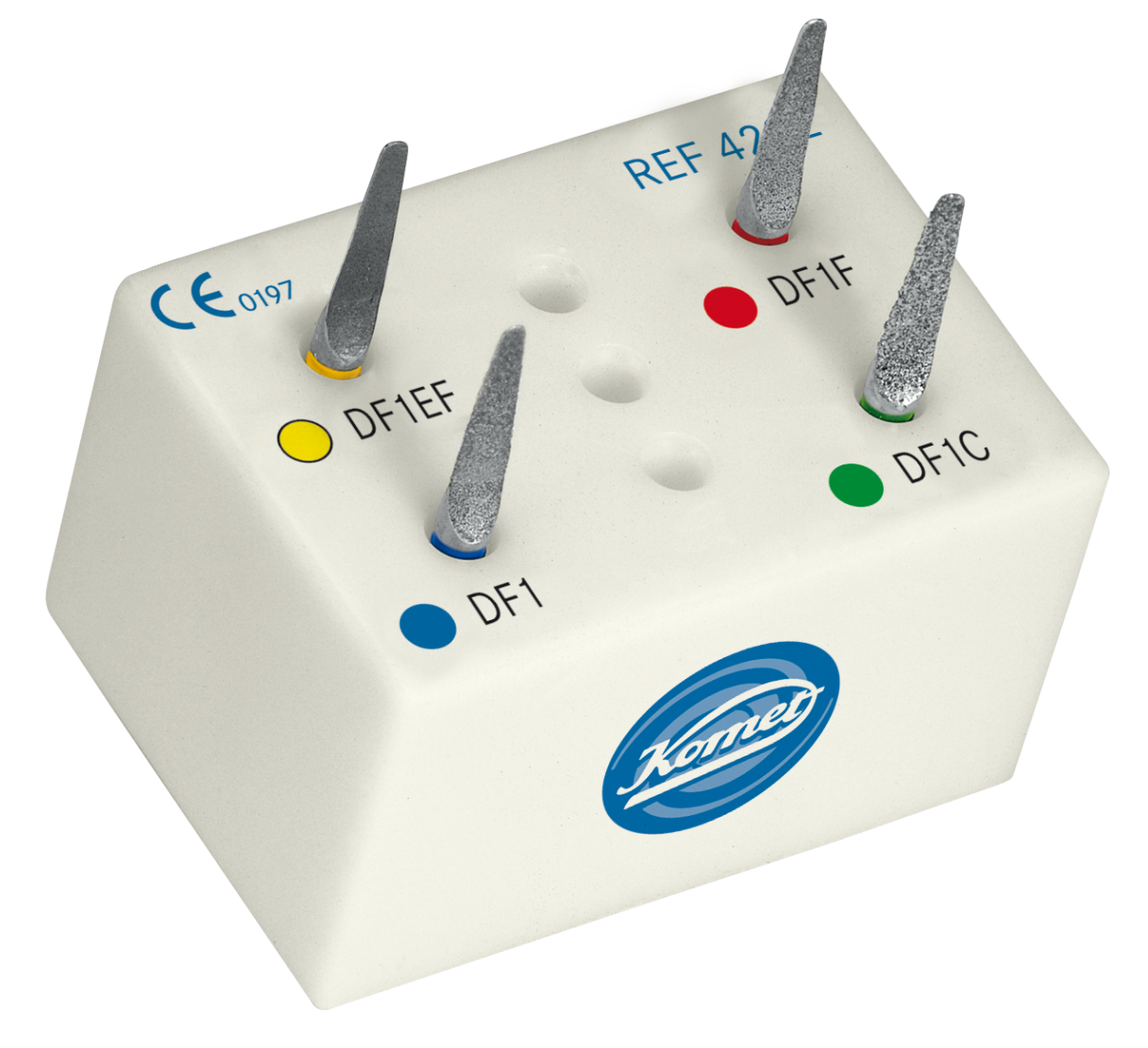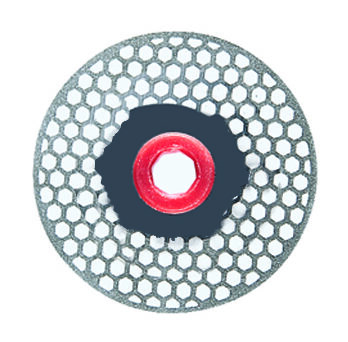Celebrate
Your Routine
And fast-track your finishing.

Finishing
In the realm of dental care, celebrating routine procedures like finishing can significantly impact patient outcomes. These tasks are fundamental not only for ensuring patient comfort but also for reducing the risk of plaque retention, thus preventing issues like secondary caries. Opting for tungsten carbide instruments rather than diamonds is recommended due to their ability to create by far smoother surfaces on dental composites. However, it’s crucial to bear in mind the subsequent polishing process when choosing a suitable finisher.
Traditionally, a 3-step method, progressing from “normal” to “fine” to “ultrafine” used to be the standard for finishing fillings. Advancements in dental technology, such as the Q-finishers developed by Komet, have revolutionized this approach. These innovative dental instruments boast a new toothing design, enabling the finishing procedure to be streamlined to just two steps. A Q-finisher is first in line, followed by an ultra-fine finisher or even switching to a 2 step polishing system. This not only enhances efficiency but also ensures that the final result meets the highest demands on surface quality. By embracing these advancements and prioritizing efficient finishing and polishing techniques, dental professionals can provide exceptional care that truly celebrates the routine workflows at their practice.
Q-Finishers

H134Q.314.014

H375RQ.314.016

H135Q.314.018

H379Q.314.018

H390Q.314.018

H48LQ.314.012

H379Q.314.023

H50AQ.314.010

H48XLQ.314.012

H246Q.314.009
Experience has shown that careful finishing of the filling material is much more efficient, as this considerably reduces the time spent polishing.
Msc. Orthodontics, Specializing in paediatric dentistry
Focusing on Q-Finishers
Achieving an impeccable final result in dental filling procedures is paramount. Specialized instruments, particularly those for interproximal surface finishing, play a crucial role in this. Traditionally, tungsten carbide finishers were the preferred choice thanks to their ability to leave a beautifully smooth surface. A 3-step method (normal-fine-ultrafine) was normally used for this, until Komet’s Q-Finishers came along and revolutionized the process. With their innovative new toothing design, they streamline the finishing process to just two steps: a Q-Finisher followed by an ultra-fine finisher.
The USPs of the Q-Finisher are evident: significant time and cost savings by eliminating one work step and, consequently, one instrument, while creating a superior surface quality even after the first finishing stage, thanks to the special cross-cut toothing tailor-made for work on fillings. Additionally, the tapered instruments H134Q and H135Q are provided with smooth, non-cutting tips to ensure gentle finishing while effectively protecting the gingiva. Moreover, a perfectly smooth surface quality greatly reduces the time needed for subsequent polishing.
Other relevant products:
Diamond Finisher

8801.314.012 – 023

8830L/RL.314.012 – 018

8835KR.314.012/014/016

8836KR.314.012 – 016

8845KR.314.018/025
Finishing sonic tips

SF58M.027
for beveling of cavity margins

SF58D.027
for beveling of cavity margins

SFM7.000
for Inlay prep. finishing

SFD7.000
for Inlay prep. finishing

SFM1F.000
for strippig

SFD1F.000
for strippig

SFM2F.000
for shaping

SFD2F.000
for shaping
Diamond honeycomb strips
for optimizing the interproximal contact
Finishing disc
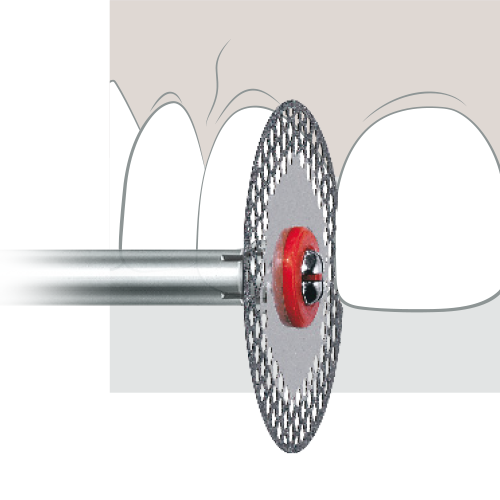
952 are finishing diamond discs used for reducing excessive filling material in the interproximal area. Use mandrel type 310 to operate the discs.

310.204
Mandrel
Find your Sales Partner
With our search function, you can find your Komet partner in over 100 countries worldwide.
Dorina Mele & Co
Rruga Prokop Myzeqari 8
1000 Tirana
Tel: +355 4 2259 425
Fax: +355 4 2267 081
Email: enton.mele@dmco.al
Web: www.dorinamele.com
EURL Healthia
149, Lot C, Draria, Alger
Algerie 16050
Tel: 00213 542693556
Email: contact@healthia.dz
A. Jasminoy S.A.C.I.
Av. Cordoba 2056
1120 Buenos Aires
Tel: +54 11 43 74 06 33
Fax: +54 11 48 04 95 20
Email: jorge@jasminoy.com.ar
P.E. Hmayak Gevorgyan
Baghramyan Ave 68/26
0033 Yerevan
Tel: +37477211213
Email: hamo.gevorgyan.med@gmail.com
Eldex
Nalbandyan st.51, apt. 17,33.,
0025 Yerevan
Tel: +37410528283
Email: info@eldex.am
Henry Schein Australia
Building 3, Level 6
189 O'Riordan Street
Mascot NSW 2020
Australia
Tel: 1300 65 88 22
Email: customer.care@henryschein.com.au
Web: www.henryschein.com.au
Komet Austria
Handelsagentur GmbH
Innsbrucker Bundesstraße 75
5020 Salzburg
Tel: +43 662 829 434
Fax: +43 662 829 435
Email: info@kometdental.at
Web: www.kometdental.at
Manama Import and Export Holding
Tel: +97317280222
Email: sahar@manamamedical.com
AlHammad
Email: actleader@outlook.com
Advance Innovation Technology plc
431/6/1East Malibag
Dhaka1217
Tel: +88 02 9357780
Fax: +88 02 8318684
Email: advinnotech@gmail.com
Web: www.advinnotech.com
OOO Technologii stomatologiy
ul. Novovilenskaya 37/47
220053 Minsk
Tel: +375 29 341 44 03
Email: n.piatrovich@yandex.ru
N.V. Codema S.A.
Schaapsdreef 27
8500 Kortrijk
Tel: +32 56 22 83 17
Fax: +32 56 22 83 24
Email: sales@codema.be
Web: www.codema.be
Dental Addict Sprl.
Gieterijstraat 39A
1601 Sint-Pieters-Leeuw
Tel: +32 02 851 11 58
Email: info@dental-addict.be
Web: www.dental-addict.be
HENRY SCHEIN Dental
Telecom Garden 2
Luchthavenlaan 20
1800 Vilvoorde
Tel: +32 2 257 40 50
Tel2: +32 2 257 40 51
Email: info@henryschein.be
Web: www.henryschein.be
KOMET USA LLC
3042 Southcross Blvd. Suite 101
Rock Hill, SC 29730
Tel: +1 888 566 3887
Email: info@kometusa.com
Web: www.kometusa.com
Adrialine d.o.o.
Ilije Garašanina b.b.
78000 Banja Luka
Tel: +387 51 490 404
Email: info@adrialine.org
Web: www.adrialine.org
Primadent d.o.o.
Cerska bb
78000 Banja Luka
Tel: +387 51 266 669
Email: info@primadent.co.ba
Web: www.primadent.co.ba
Medix Suppliers
Unit 29 & 30, 1st Floor
Banguan Ahmad Bin Hassan Dan Anak Anak
SPG 88, Jalan Kiulap Bandar Seri Begawan BE 1518
Brunei Darussalam
Tel: +673 223 6015
Fax: +673 223 6866
Email: lingytmedix@gmail.com
Komet Brazil, Lesell
Rua César de Menezes, 50 Vila Homero Thon Santo André
Sao Paulo
Tel: +55 11 44741100
Fax: +55 11 44740563
Email: komet@komet.com.br
Web: www.komet.com.br
Chimtrade-Komet Ltd.
blvd. "Tzar Boris III" 81
1612 Sofia
Tel: +359 2 953 13 10
Email: office@chimtrade.info
Web: www.chimtrade.bg
Engold Co. Ltd
#375, Street 1019, Banlar S'et, Sangkat Boeung Salang
Khan Sen Sok
Phnom Penh
Tel: +855 23 4588588
Email: info@engold.com.kh
Web: www.engold.co
Mandara SARL
Bonamoussadi, Kotto, Montee Bloc L
Douala BP 8427
Email: info@mandarasupplies.com
Web: www.mandarasupplies.com
Westan Dental Products Group
634-Erin Street
Winnipeg, Manitoba
R3G-2V9
Tel: +1 888 477 9378
Fax: +1 204 947 1651
Email: troybwestan@shaw.ca
Web: www.westan.ca
KOMET USA LLC
3042 Southcross Blvd. Suite 101
Rock Hill, SC 29730
Tel: +1 1 800 208 1630
Fax: +1 1 800 223 7485
Email: info@kometusa.com
Web: www.kometusa.com
Clinical Research Dental (CRD)
167 Central Ave, Suite 200
London, Ontario, Canada N6A 1M6
Tel: +1-800-265-3444
Email: customerservice@clinicalresearchdental.com
Web: www.clinicalresearchdental.com
Brodent
Arlegui 440
Local 216, Edificio Arcadia
Viña del Mar
Chile
Tel: +56 9 93305578
Email: info@brodent.cl
Web: www.brodent.cl
MedicalTek
Moneda 856 - Local F
Santiago de Chile
Chile
Tel: +56 2 6397654
Fax: +56 2 6321049
Email: rbacquet@medicaltek.cl
Web: www.medicaltek.cl
Schudent Ltda.
Av. Providencia 2653, Local 39
Tel: +56 2 22322753
Tel2: +56 2 22321895
Email: info@schudent.cl
Tel: +86 21 5234 0096
Fax: +86 21 5234 0097
Email: info@brasseler.com.cn
Shanghai Yujing Trading Co. Ltd.
Room 1112, Block A
SOHO Zhongshan Plaza
No. 1055 West Zhongshan Rd.
Changning District
200051 Shanghai, P.R.China
Tel: 0086-21-80121250
Fax: 0086-21-62175264
Web: www.shanghaiyujing.com
Dentales Estudio
Tatiana Simanca Roa
Calle 46 No 13-26
Bogotá
Tel: +57 12858569
Email: tatianasimanca@hotmail.com
INNOVACIONES DENTALES
P.O. Box 1262-1200 Pavas
San José
Tel: +506 2232 95 95
Fax: +506 2231 18 81
Email: yolanda@innovacionesdentales.com
M.T.F. d.o.o.
Hondlova 2
10 000 Zagreb
Tel: +385 1 239 67 60
Fax: +385 1 231 26 12
Email: mtf@mtf.hr
Web: www.mtf.hr
PANDENT d.o.o.
Ogrizoviceva 40c
10000 Zagreb
Tel: +385 1 366 65 40
Fax: +385 1 366 65 45
Email: info@pandent.com
Web: www.pandent.com
Health Pro Ltd
Leontiou A 183, Leontiou Center Block C
3020 Limassol
Tel: +357 25 87 72 40
Fax: +357 25 87 72 41
Email: info@orphanosgroup.net
Web: www.orphanosgroup.net/healthpro
Janouch Dental s.r.o.
Malá Dlážka 17
Prerov 750 02
Tel: +420 604 251 198
Email: info@janouch-dental.cz
Web: www.janouch-dental.cz
MAXDENT s.r.o.
Místecká 194
73921 Paskov
Tel: +420 591 141442
Email: info@max-dent.cz
Web: www.max-dent.cz
Rotadent spol. s r.o.
Špidrova 104
Vimperk 385 01
Tel: +420 388 323991
Fax: +420 388 320835
Email: info@rotadent.eu
Web: www.rotadent.eu
4Dent s.r.o.
Klatovska trida 79
301 00 Plzen
Tel: +420 377 420 276
Fax: +420 377 420 276
Email: info@4dent.cz
Web: www.4dent.cz
Henry Schein s.r.o.
Černokostelecká 2085/24
100 00 Praha
Tel: +420 800 700 097
Email: obchod@henryschein.cz
Web: www.henryschein.cz
Plandent A/S
Jydekrogen 16
2625 Vallensbaek
Tel: +45 43 66 44 44
Fax: +45 43 66 44 00
Email: plandent@plandent.dk
Web: www.plandent.dk
IMECO
4 Mohamed Moussa St.
Azarita
Alexandria
Tel: +20 3 4871264
Tel2: +20 1065525826
Fax: +20 3 4879621
Email: imeco_eg@yahoo.com
DAB Esti OÜ
Tulika 19
10613 Tallinn
Tel: +372 50 372 12
Email: niina.saaremagi@dabdental.ee
Web: www.dabdental.ee
Dentalmarket.ee
Tuisu 19
11314 Tallinn
Tel: +372 555 707 01
Email: info@dentalmarket.ee
Web: www.dentalmarket.ee
HAMMASVÄLINE OY
P.O. Box 15
02101 Espoo
Tel: +358 10 5 88 60 00
Fax: +358 10 5 88 69 99
Email: katriina.polttila@hammasvaline.fi
Web: www.hammasvaline.fi
Plandent OY
Asentajankatu 6
00880 Helsinki
Tel: +358 20 357 561
Fax: +358 20 7795 206
Email: myynti@plandent.com
Web: www.plandent.com/sv-fi
KOMET FRANCE SA
18, Rue Fourcroy
75017 Paris
Tel: +33 1 43 48 89 90
Fax: +33 1 43 48 90 65
Email: info@komet.fr
Web: www.komet.fr
Sprint-Dental LTD
0160 O. oniashvili st
Tbilisi
Georgia
Tel: +995 557 00 75 57
Email: sprint.dental@yahoo.com
Web: www.sprintdental.ge
Komet Dental
Gebr. Brasseler GmbH & Co. KG
Trophagener Weg 25
32657 Lemgo
Tel: +49 5261 701 0
Fax: +49 5261 701 289
Email: info@kometdental.de
Web: www.kometdental.de
WRIGHT-COTTRELL & Co.
Kingsway West
Dundee DD2 3QD
Tel: +44 800 66 88 99
Fax: +44 800 37 45 11
Email: info@wright-cottrell.co.uk
Web: www.wright-cottrell.co.uk
Abbey Dental Supplies
4 Imperial Way
Croydon Surrey CR0 4RR
Tel: +44 208 6 83 45 28
Fax: +44 208 6 84 09 34
Email: phil@abbeydentalsupplies.com
Web: abbeydentalsupplies.com
Ortho-Care (UK) Ltd
1, Riverside Estate
Saltaire, West Yorkshire, BD17 7DR
Tel: +44 1274 533233
Email: info@orthocare.co.uk
Web: www.orthocare.co.uk
Maurice Faraggi S.A.
43 Fidippidou Str.
Athens 11527
Tel: +3 210 7 48 90 31
Fax: +3 210 7 48 90 32
Email: info@faratzi.gr
Web: www.faratzi.gr
Interdental Ltd.
Room 2003-04, 20/F, The 80I20
No.161 Wai Yip Street
Kwun Tong
Tel: +852 25 41 10 96
Fax: +852 25 41 55 53
Email: wayne@interdental.com.hk
Realtrade Kft
Hölgy u. 9/b.
1102 Budapest
Tel: +36 1 261 6630
Fax: +36 1 261 4348
Email: info@realtrade.hu
Web: www.realtrade.hu
Dental Depot
Katica u. 1. fsz. 24
1191 Budapest
Tel: +36 30 830 4735
Email: t.kakonyi@dentaldepot.hu
Web: www.dentaldepot.hu
HENRY-SCHEIN FIDES
Laufasgata 9
600 Akureyri
Tel: +354 5 88 89 99
Fax: +354 4 61 11 39
Email: inging@henryscheinfides.is
Web: www.henryscheinfides.is
EXCEL INTERNATIONAL
A-48 Friends Colony (East)
New Delhi 110065
Tel: +91 11 26927444
Fax: +91 11 6828520
Email: excelint@airtelmail.in
SHREE MEDICO
B-227 & 229, SUPATH-II Complex
Nr. St. Laurn Tower, Old Vadaj
Ashram Road
Ahmedabad-380013
Tel: +91 79 48928954
Tel2: + 91 9327124679
Fax: +91 79 2755 7160
Email: rupendra1313@gmail.com
DENTCARE DENTAL LAB PVI LTD.
PLOT NO. 17, IIrd FLOOR
COCHIN SPECIAL ECONOMIC ZONE
Near K.S.R.T.C.
KAKKANAD - 682037, KERALA
Tel: +914852835112
Fax: +91 4852830159
Email: purchase@dentcaredental.com
India Viking ImpEx Private Limited
House No:558 First Floor
Silver Oak Marg, Ghitorni
New Delhi -110 030 India
Tel: + 91 98114 83567
Tel2: + 91 98913 43724 (Whatsapp)
Email: Info@IndiaViking.com
Web: www.indiaviking.com
Fondaco
APL TOWER, PODOMORO CITY
27th Floor, Suite 2. Jl. Letjen S. Parman Kav. 28
Tel: +62 21 2903 4388
Fax: +62 21 2903 4391
Email: fondaco@fondaco.co.id
Ronaghi Dental Co.
No. 68, Dental Center
Nawab Highway
Tehran
Tel: +98 21 66380 390
Tel2: +98 21 66380 391
Fax: +98 21 66380392
Email: info@ronaghitrading.com
RETAJ-Al Iraq Bureau
Bab Al Muadhaam, Near Ministry of Health
Dr. M.K. Gholam
IRAQ
Tel: +964 77 02 51 56 97
Tel2: +964 79 01 34 94 30
Email: retajcom@yahoo.com
ARDAGH DENTAL SUPPLY CO. LTD.
Euro House, Unit 4 East Wall Road
Dublin 3
Tel: +353 1 8551600
Fax: +353 1 8363991
Email: johng@ardaghdental.ie
Web: www.ardaghdental.ie
A. Levy Dental Co. Ltd
27, Kalisher Str.
Tel Aviv 6516506
Tel: +972 3 5173150
Fax: +972 3 5164427
Email: levydent@netvision.net.il
Web: www.dentaldepot.co.il
KOMET ITALIA S.r.l.
Via Gianbattista Morgagni, 36
37135 Verona
Tel: +39 45 11 17 19 11
Email: info@komet.it
Web: www.komet.it
MOMOSE DENTAL MANUFACTURING CO. LTD.
6-35 Minami-Kawahoricho Tennoji-Ku
Osaka 543-91
Tel: +81 6 773 333
Fax: +81 6 773 3361
Email: intl-div@momose-dm.co.jp
Web: www.momose-dm.co.jp
Basamat Pharmadent
P O Box: 141375
Amman 11814
Tel: +962795045700
Fax: +962 (6) 5 67 58 99
Email: ziad@basamat.com
DentalCom/Mega-Dent UG
Schultheißenweg 105bc
60489 Frankfurt/Main
Tel: +7 701 588 88 14
Tel2: +7 777 850 29 35
Email: info@kz-dentalcom.com
Web: www.kz-dentalcom.com
Kenhara
Fortis office park, Block C, Ground and First Floor
00100 Nairobi
Muthangari Dr, Westlands
Tel: '+254712344183
Email: info@kenhara.com
Web: www.kenhara.com
N.T.Allianz
Hyrja 8, Veternik, Kompleski EXDC 2
10000 Prishtine
Kosovo
Tel: +381 38 246 146
Fax: +381 38 246 146
Email: allianz_kosovo@yahoo.com
UMT - United Medical Technologies
P.O. Box 588, Code 15256
Al-Souk Al Dakhely
Tel: +965 5 67 21 57
Fax: +965 567 21 90
Email: yousef@umt.com.kw
Web: www.umt.com.kw
H.A.R.D. Sarl.
28E, Route de Moufia
97490 Sainte Clothilde
Tel: +262 293336
Fax: +262 292585
Eiro Med
Siguldas soseja 11
Bergi Rigas raj. 1024
Tel: +371 2 6456153
Email: info@eiromed.lv
Web: www.eiromed.lv
SIA KMIK
Ropažu iela 60a
LV-1006 Riga
Tel: +371 29001499
Email: dentalkmik@gmail.com
Web: www.zobarstam.lv
PHARMACOL
Abboud Center - 3rd Floor
Rabieh Main Road
Metn
Tel: +961 4 52 42 47
Fax: +961 4 52 52 78
Email: info@pharmacol1.com
Al-MAGD Medical Requirements & Equipment
3-5 Zaid Ben-Tabit Street
Area 7 Ben Ashor
P.O. Box 80100
Tripoli
Tel: +218 21 3 61 01 54
Fax: +218 21 3 61 01 55
Email: mgdent@gawab.com
MP Dental UAB
Žozefo Pusjė str. 9
14188 Vilnius
Tel: +370 5 213 66 48
Fax: +370 5 213 88 20
Email: info@mpdental.lt
Web: www.mpdental.lt
DENTOMED-M
Str. Bojmija 2/2
1000 Skopje
Tel: +389 2 246 2739
Email: dentomed@t.mk
Bumi Dental Suppliers
No 37 Jalan SS21/1A
Damansara Utama
47400 Petaling Jaya
Selangor Darul Ehsan
Tel: +603 77280821
Fax: +603 77295937
Email: enquiry@bumidental.com.my
Galla Dental Corp. Sdn Bhd
Jalan Rimbunan Raya, Laman
Rimbunan 40-1, Kepong
52100 Kuala Lumpur
Tel: +603 6259 3800
Fax: +603 6259 3808
Email: info@galladental.com
Cherubino Ltd
Delf Building, Sliema Road
Gzira GZR1637
Tel: +356 21 34 32 70
Fax: +356 21 33 09 16
Email: info@cherubino.com.mt
Web: www.cherubino.com.mt
Bart Enterprises Ltd
42a, Triq il-Kbira
Balzan BZN 1259
Tel: +356 21 44 73 40
Fax: +356 21 44 73 41
Email: info@bart.com.mt
CLAIRE DENT
6. Rue Ghandi, premier etage
PO Box: 10000
Rabat
Morocco
Tel: +212 5377 26264
Email: clairedent6@gmail.com
SERGE DENTAL SUPPLIES
38 Emmanuel Anquetil Street
Port-Louis
Tel: +230 216 3313
Fax: +230 240 3199
Email: sgdental@intnet.mu
Centro Logístico Vital CLV S.A.
Boulevard de los Reyes
6204- A7 Int. 301-3 Col. San Martinito
72825 San Andrés Cholula, Puebla, Mexico
Tel: 55-2930-9422
Email: marketing@clvmexico.com
Web: www.clvmexico.com
Super-Dent SRL
Columna 171
2004 Chisinau
Tel: +373 22 235 017
Email: info@super-dent.md
Web: www.super-dent.md
Medipro International doo
Neznanog Junaka 37
11000 Beograd
Tel: +381 11 3675888
Fax: +381 11 3674 759
Email: office@medipro.co.rs
Web: www.medipro.rs
Mingalars
Junction City Tower, No.3/a
Bogyoke Aung San Road
Pabedan Township; Yangon; Myanmar
Email: info@mingalars.com
Web: www.mingalars.com
OrangeService Dental B.V.
Daltonstraat 1
3335 LR Zwijndrecht
Tel: +31 235493040
Email: Verkoop@orangeservicedental.nl
Web: www.orangeservicedental.nl
Henry Schein Dental
Veluwezoom 16
1327 AG Almere
Tel: +31 36 535 86 00
Fax: +31 36 535 86 08
Email: info@henryschein.nl
Web: www.henryschein.nl
Plandent BV
Ravenswade 54
3439 LD Nieuwegein
Tel: +31 30 2 88 88 88
Fax: +31 30 2 88 50 02
Email: verkoop@plandent.nl
Web: www.plandent.nl
Hofmeester Dental B.V.
Andries Copierhof 2
3059 LM Rotterdam
Tel: +31 10 286 3000
Fax: +31 10 286 3009
Email: verkoop@hofmeester.nl
Web: www.hofmeester.nl
Dentalair Products Nederland B.V.
Wieldrechtseweg 26
3316 BG Dordrecht
Tel: +31 78 654 37 37
Email: info@dentalair.nl
Web: www.dentalair.nl
Arthodent B.V.
Plantijnweg 27
4104 BC Culemborg
Tel: +31 345 51 80 04
Fax: +31 345 51 29 29
Email: verkoop@arthodent.nl
Web: www.arthodent.nl
Basiq Dental BV
Bedrijfsweg 4
5061 JZ Oisterwijk
Tel: + 31 13521 9120
Email: info@basiqdental.nl
Web: www.basiqdental.nl
American Dental Trading BV
Laarakkerweg 5
5061 JR Oisterwijk
Tel: + 31 13528 8055
Email: verkoop@adt.nl
Web: www.adt.nl
Intermed S.A.
B.P. 1411, 17 Rue Ampére - Ducos
98845 Noumea Cedex
Tel: +687 24 61 40
Fax: +687 26 38 69
Henry Schein Dental
243-249 Bush Road Rosedale
Auckland
New Zealand, 0632
Tel: +64 9 414 0040
Fax: +64 9 414 0041
Email: info@henryschein.co.nz
Web: www.henryschein.co.nz
Plandent AS
Østensjøveien 27
0601 Oslo 6
Tel: +47 22 07 27 27
Fax: +47 22 07 27 87
Email: ordre.forbruk@plandent.no
Web: www.plandent.no
AL MAZROUI MEDICAL & CHEMICAL SUPPLIES
P.O. Box 1259
R.C. 112 Ruwi
Tel: +968 24 59 46 44
Fax: +968 24 59 45 25
Email: almaz@omantel.net.om
Ibn Sina Pharmacy LLC.
P.O. Box 682
117 Wadi Kabir
Tel: 00968 24 82 210
Fax: 00968 24 81 34 72
Email: info@ispoman.com
Web: www.ispoman.com
Ebin Rushed Pharmacy Co. LLC
Suhail Bahwan Group
P.O. Box 169
Muscat, 113
Tel: 00968 2 47 93 75 04 21
Fax: 00968 24 70 15 47
Email: sandeepkunder@suhailbahwangroup.com
Web: www.suhailbahwangroup.com
Spine Marketing Services
Office no. 02, Mezzanine Floor
Building 6-C, Jami commercial
Street-12, lane-26, Phase VII
Karachi
Tel: +92 21 354 501 61
Fax: +92 21 351 364 01
Email: info@spinemarketing.pk
Khader Dental Center
Tel: +970599336725
Email: khader.anes@yahoo.com
Medidental
Paul Furman
Panama: Parque industrial costa del este ed.Maloul
Chiriqui: Diagonal al hospital Chiriqui
NUEVA OFICINA CHITRE: Frente a hospital C. Castillero
Tel: +507 399 2530
Fax: +507 399 2531
Email: info@medidental.com.pa
Web: www.kometusa.com
DEI Import & Export SRL
Avenida Fernando De la Mora
988 Barrio Vista Alegre
Asuncion
Tel: +59521608919
Email: odontodaniel@hotmail.com
One Gantech Industries Inc.
Rm. 407 4/F Chunics Bldg.
3368 Ramon Magsaysay Blvd.
Barangay 627 Zone 063 1008 Sta. Mesa Manila
Tel: +639173164262
Email: brianlam@gaocdental.com.ph
Marrodent sp. z.o.o
ul. Krasinskiego 31
43-300 Bielsko-Biala
Tel: +48 338152013
Fax: +48 338152267
Email: joanna.fafara@marrodent.pl
Web: www.marrodent.pl
KALMA S.A.
Javier Fernández
Delegação Portugal
Tel: +34616973234
Email: javier.fernandez@grupokalma.com
KOMET USA LLC
3042 Southcross Blvd. Suite 101
Rock Hill, SC 29730
Tel: +1 1 800 208 1630
Fax: +1 1 800 223 7485
Email: info@kometusa.com
Web: www.kometusa.com
ACCROSS Trading Company
P.O. Box 23006
Doha
Tel: +974 44 88 65 11
Fax: +974 44 80 70 14
Email: info@accros.org
Web: www.accros.org
IRE Novodent
Blv. Decebal, A1/32
Deva
Tel: +40 723 665 367
Email: office@irenovodent.ro
Web: www.irenovodent.ro
Dentex Trading
Str. Vatra Luminoasa 47
Sector 2 - Bucuresti
Tel: +40 21 256 91 33
Fax: +40 21 250 10 98
Email: sales@dentex.ro
Web: www.dentex.ro
DDI-Derom Dental International
Str. Inculet nr. 3
Iasi, 700720
Tel: +40 232 225 276
Fax: +40 232 211 448
Email: mail@ddi.ro
Web: www.ddi.ro
Sitea
STR. OLTARULUI NR 4, SECTOR 2
020765 - BUCHAREST
Tel: +40 21 52 80 320
Email: raluca@sitea.ro
Web: www.sitea.ro
Yulia Kabirova
Sales & Marketing Representative
Sr. Pereyaslavskaya St. 2 - 38
129110, Moscow
Tel: +7 903 180 6408
Email: ykabirova@kometdental.ru
Web: www.kometdental.ru
DinaMedika-Novosibirsk
Schetinkina St.32 office 1
630099, Novosibirsk
Tel: +7 383 218 0684
Email: dent-med@dinamedika.ru
Web: www.dinamedika.ru
D&G Stom
2nd Roshchinsky passsage
Bld.8, office 1004
115419, Moscow
Tel: +7 495 445 40 04
Email: info@dgstom.ru
Web: www.dgstom.ru
Stomport
Altufevskoe Rd. 48, bld. 3
127566, Moscow
Tel: +7 495 150 1016
Email: sales@stomport.com
Web: www.stomport.com
German Dental Technology
454025, Chelyabinsk
Tel: +7 904 944 2603
Email: tz@nemstom.com
Snabmed
Dorozhnaya St. 60 B, off. 106
117405, Moscow
Tel: +7 499 455 1045
Email: info@snabmed.com
Web: www.snabmed.com
Stomus
Lunacharskogo Ave. 49
194291, Sankt-Petersburg
Tel: +7 812 702 4007
Email: office@stomus.ru
Web: www.stomus.ru
Stommarket
690000, Vladivostok
Tel: +7 423 240 6890
Email: info@stommarket.com
Hariko Denta Med
Derbenevskaya Qy. 11, bld. B
115114, Moscow
Tel: +7 495 913 6606
Email: gevorg.petrosian@hariko.ru
Web: www.hariko.ru
Estetika-Dent
Lomonosov St. 11А
660049, Krasnoyarsk
Tel: +8 800 333 6641
Email: info@esteticadent.com
Web: www.esteticadent.com
Echo
Sverdlova St. 82
353905, Novorossiysk
Tel: +7 861 761 8084
Email: dental@echo-nvrsk.ru
Web: www.echo-nvrsk.ru
Astra-referens
Dachnaya str., 24, of. 111, BC Finhouse
443013, Samara
Tel: +7 846 243 24 29
Email: astra-referens@mail.ru
Web: астра-референс.рф
Thimar Al-Jazirah Corp.
Heamthcare & Pharmaceuticals
Prince Fawaz Ibn Abdulaziz Street
Malaz District
P.O. Box 523
Riyadh 11421
Tel: +966 1 445 45 45
Fax: +966 4 497 88 00
Email: dental@thimar.com
Sté Bonfoni
85, Résidences Mourtada 2
12000 Yoff Dakar
Zone ouest foire extension – VDN
Tel: +221 33 867 23 64
Email: aziz@bonfoni.com
Web: www.bonfoni.com
Delta Medical
11 Rue Thiong
B.P. 7769 Dakar
Tel: +221 33 889 37 37
Email: delta@deltamedical.sn
Web: www.deltamedical.sn
Medipro International doo
Neznanog Junaka 37
11000 Beograd
Tel: +38111 3675 888
Fax: +38111 3674 759
Email: office@medipro.co.rs
Web: www.medipro.rs
Chee Sang Dental Supply Pte Ltd.
57 Ubi Ave 1
#04-01 Ubi Centre
Singapore 408936
Tel: +65 67460602
Fax: +65 67460187
Email: info@cheesang.com
Web: www.cheesang.com
DentAll spol. s.r.o.
Záhradná 30
08001 Presov
Tel: +421 51 758 2006
Fax: +421 51 758 2007
Email: dentall@dentall.sk
Web: www.dentall.sk
Futurum s.r.o.
Tatranská 304
01701 Povazská Bysrica
Tel: +421 42 432 59 98
Fax: +421 42 432 59 98
Email: sales@futurum.sk
Web: www.futurum.sk
Dentalia d.o.o
Celovška cesta 201
1000 Ljubljana
Tel: +386 01 583 77 30
Fax: +386 01 510 32 15
Email: info@dentalia.si
Web: www.dentalia.si
Istrodent (Pty) LTD
14 Cosmic St & Milkyway Ave
Linbro Business Park
P.O.Box 400
2090 Sandton
Tel: +27 11 608 11 11
Fax: +27 11 608 11 22
Email: tsipi@istrodent.com
Web: www.istrodentshop.com
Champions Implants Africa (Pty) Ltd
22 Henschell Road
7806 Cape Town
Hout Bay
Cape Town
Tel: +27 76 036 2600
Email: africa@champions-implants.co.za
KOMET DMI KOREA
Rm 507, 27, Chilpae-ro, Jung-gu
Seoul 04511
Tel: +82 2 3788 9500
Email: komet@shinwon-dental.com
Web: www.kometshop.co.kr
KALMA S.A.
Avenida de las Nieves, 4
28935 Móstoles
Madrid
Tel: +34 91 380 23 83
Email: kalma@kalma.es
Web: www.kalma.es
Dentalmind AB
Vindåkersvägen 10
SE-311 50 FALKENBERG
Tel: +46 346 488 00
Fax: +46 346 240 65
Email: info@dentalmind.com
Web: www.dentalmind.com
Rodent AG
Dorfstrasse 60
9462 Montlingen
Schweiz
Tel: +41 71 763 9060
Fax: +41 71 763 9068
Email: dental@rodent.ch
Web: www.rodent.ch
Säntis Dental GmbH
Im Grund
9044 Wald / AR
Tel: +41 71 877 20 88
Fax: +41 71 877 20 84
Email: saentisdental@bluewin.ch
Web: www.saentisdental.ch
HANS TREICHLER & Co. Dentalwaren
Inhaberin Patricia E. Treichler
Zürcherstrasse 20
8952 Schlieren
Tel: +41 44 4915007
Fax: +41 44 4011208
Email: info@dentalwaren-treichler.ch
Kaladent AG
Schachenstrasse 2
9016 St. Gallen
Tel: +41 844 353 535
Fax: +41 844 353 536
Email: info@kaladent.ch
Web: www.kaladent.ch
Curaden AG
Amlehnstrasse 22
6010 Kriens
Tel: +41 413194500
Fax: +41 413194590
Email: info@curaden.ch
Web: www.curaden-dentaldepot.ch
Dema Dent AG
Furtbachstrasse 18
8107 Buchs
Tel: 0800 400 555
Email: bestellungen@demadent.ch
Web: www.demadent.ch
Ouzoun Trading Center
Al-Telyani Av.
Omar Al-Mokhtar Str.
Damascus
Tel: 00963 11 443 0548/9
Email: abdallaouzoun@ouzoun.com
ORINA
B.P. 6938
Faa'a
Tel: +689 42 11 73
Fax: +689 43 46 40
JOYO WELLDENT Co. Ltd.
6 F, 384, Song Her Street
Taipei
Tel: +886 2 27885088
Fax: +886 2 27885093
Email: welldent@ms29.hinet.net
United Medical Specialties Corp.
7F, No.112, Guangfu North Road
Songshan District, Taipei City City 10560
Taiwan
Tel: +886 2 2577 6630
Fax: +886 2 2577 8830
Email: ums@ums.com.tw
Web: www.ums.com.tw
TAY KOK CHAI
580-582 New Road
Bangkok 10100
Tel: +66 2 2216553
Fax: +66 2 755 6565
Email: tkc2000@ksc.th.com
NUVODENT CO. LTD.
419/165 Tippawan 1 Moo 5 Soi 14
Theparak Rd.
Theparak, Muang
Samutprakarn 10270
Thailand
Tel: +66 2 755 6636
Fax: +66 2 394 4403
Email: george@nuvodentthai.com
Promosciences
Z.I. Carquia, rue no. 7, Cathage
Tunis, Tunisie
Tel: +216 71 77 25 00
Email: promosciences@planet.tn
MEDIFARM DIS TICARET VE Pazarlama Ltd.
Cevizli Mh. Tugay yolu Cd.
Pol-Ar Is Merkezi No:13 Kat: 1-2
Maltepe / Istanbul
Tel: +90 216 352 03 03
Fax: +90 216 352 03 99
Email: info@medifarm.com.tr
Web: www.medifarm.com.tr
BOLOUR DENTAL SAGLIK LIMITED SIRKETI
Hasanpaşa Mah. Mahmut Baba SK.
No:21/B
Kadıköy
İstanbul
Tel: +90 216 606 6060
Tel2: +90 539 460 1449
Email: bolourdental.ltd@gmail.com
Web: www.bolourdental.com.tr
Sante Dental Tibbi Ürünler Sanayi ve Tic. Ltd. Sti.
Molla Gürani MH
Turgut Özal Millet Cad, Fildisi
Cemberlitas, ISTANBUL
Tel: +902125320086
MPC - Modern Pharmaceuticals Company
71 Ibn Ishaq Building
Dubai Health Care City
P.O. Box 1586
Dubai
Tel: +971526072838
Fax: +971 4 35 72 255
Email: bdaamach@mpchealthcare.com
Web: www.mpchealthcare.com
InSpe
42, Br. Mikhnovskykh Str.
79018 Lviv
Tel: +380 322 403705
Fax: +380 322 403588
Email: info@inspe.ua
Web: www.inspe.ua
Ltd. Ivodent
Chornovola str. 47
76018 Ivano-Frankivsk
Tel: +38 342 55 94 55
Fax: +38 342 55 94 55
Email: ivodent.if@gmail.com
Web: www.ivodent.com.ua
VK Import Ltda
Santana 1686
11400 Montevideo
Tel: +598 2 619 9167
Fax: +598 2 613 5328
Email: info@vkimport.com.uy
KOMET USA LLC
1057 Red Ventures Drive, Suite 100
Fort Mill, SC 29707
Tel: +1 888 566 3887
Email: info@kometusa.com
Web: www.kometusa.com
Seadent Joint Stock Company
13 Đặng Tất, Phường Tân Định, Quận 1
Hồ Chí Minh
Tel: +84 (028)35100880
Fax: +84 (028)38209100
Email: info@seadent.com.vn
Web: www.seadent.com.vn
Elegant Med. Suppliers and Solution
Marina Twin Tower B, Floor 18 Office 184
Lusail Area, Doha, Qatar
Tel: 97441403007
Email: info@elegant med.net
Modern Medical Equipment (LLC)
Shop 15, Danata AlKhaleej Building
AlKhaleej Road
Dubai, UAE
Tel: 009714 2366604
Email: Dubai@mmeco.ae
Our international subsidiaries
Let our experts consult you in your practice or laboratory or buy the products comfortably in our local online stores.
